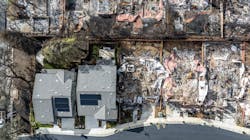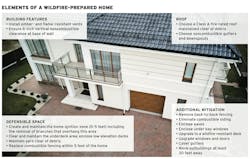7 Ways to a Wildfire-Prepared Home
For most Americans living in the western United States, wildfire is an ongoing threat. As of March 2025, more than 7,000 wildfires have burned over 146,000 acres of land, and 4.5 million homes have been identified at high or extreme risk of wildfire, with more than 2 million in California alone.
As wildfires encroach on our communities, dry conditions, high winds, and elements of the built environment can turn these wildfires into devastating conflagration events.
How to Stop the Spread of Wildfire
While wildfire is a natural part of the ecosystem, what can be done to stop the spread of wildfire into our communities?
After a career with the California Department of Forestry and Fire Protection, I was pleased to join the Insurance Institute for Business & Home Safety (IBHS), a nonprofit dedicated to developing real-world solutions for home and business owners to better protect against wildfire and severe weather.
IBHS research shows there are mitigation actions that both homeowners and builders can take to meaningfully reduce wildfire risk to homes.
In 2022, IBHS launched Wildfire Prepared Home, the first-ever designation program that allows homeowners and builders to implement a system of science-backed mitigation actions to reduce a home’s risk from the ignition mechanisms of embers, radiant heat, and direct flame contact.
As of March 2025, more than 7,000 wildfires have burned over 146,000 acres of land, and 4.5 million homes have been identified at high or extreme risk of wildfire ... 2 million in California alone.
While certain steps can and should be taken by homeowners of new and existing homes after occupancy, the Wildfire Prepared Home Plus designation is best suited for new construction and provides a road map for builders to bring greater resilience to their projects.
Additional Measures to Protect Homes From Fire
In addition to the requirements from the Wildfire Prepared Home Base designation level (scroll down to see The Basics of Wildfire Preparedness sidebar, below), the Plus level includes additional protective measures for a home's key building features to defend against radiant heat and direct flame contact, as well as embers.
Consider these 7 best practices:
- Cover gutters: Install noncombustible gutter guards.
- Enclose eaves: Enclose eaves or soffits with noncombustible material.
- Install noncombustible siding: Choose a noncombustible siding option, such as fiber cement, stucco, stone, or brick.
- Upgrade windows: Install exterior windows with at least two panes of tempered glass.
- Upgrade doors: Install noncombustible exterior doors—solid-core wood not less than 1 ¾ inches thick or with a fire-resistance rating of no less than 20 minutes—and a noncombustible threshold.
- Upgrade decks: Upgrade to noncombustible posts, joists, and walking surface materials to reduce the chance of ignitions below and on top of decks.
- Reduce exposure from accessory dwelling units and accessory structures: Locate accessory dwelling units and accessory structures a minimum of 30 feet away from the home.
Wildfire Safe Resources ... and Costs
The Wildfire Prepared Home program includes built-in educational resources to help homeowners and builders better understand and complete program requirements.
Home builders in wildfire-prone areas are encouraged to build to the Wildfire Prepared Home Plus standard to significantly reduce property wildfire risk, while California and Oregon homeowners can go a step further to receive a designation, which can be used to discuss coverage and possible incentives with insurers.
RELATED
- The Need for Resilient Construction Is Real. How Are Home Builders Responding?
- 3 Factors That Amplify a Building's Resilience
- How to Design and Build Homes to Withstand Wildfires
These mitigation actions need not be costly. A 2024 study by nonprofit research group Headwaters Economics found that retrofitting a home for greater wildfire resistance can cost as little as $2,000, while a previous study conducted by IBHS and Headwaters found that newly constructed homes can be mitigated for wildfire for less than $3,000.
Many of the mitigations can be done as simple projects, such as removing vegetation in Zone 0 (zero)*, which nearly doubles a property’s survival rate according to a 2021 study from property risk analytics company Zesty.AI and IBHS.
Zone 0 is the horizontal area within the first 5 feet of the home and any outbuildings and attached decks and stairs. This zone focuses on intense fuel reduction to protect against ember attacks and includes plants, decks—and the area under attached decks and stair landings—outdoor furniture, and the home's exterior walls and coverings.
The Benefits of Creating Resilient Communities
IBHS’ 2023 Lahaina Conflagration study following the devastating wildfires on Maui, Hawaii, in 2022 shows that unless immediate action is taken at both the parcel and community levels, conflagration events will continue to destroy communities. When multiple homes within a community are mitigated to reduce wildfire risk, entire neighborhoods can benefit.
As a result, IBHS is working to develop the first-ever wildfire mitigation designation program designed to increase community resilience.
Expanding on the current parcel-focused Wildfire Prepared Home, this new program will consider existing and controllable factors to develop a tailored mitigation plan that fits the specific needs of a community.
The new program will focus on reducing the exposure of connective fuels around and within a community and increasing the resilience of homes' exterior building materials, which often lead to conflagration events.
Mitigating against wildfire is possible, and as wildfires continue to grow in frequency and intensity, the time to act is now.
Builders working in areas at threat of wildfire can serve as industry trailblazers, reducing property wildfire risk through simple, affordable changes at the point of new construction, using IBHS research to take the first step.
The Basics of Wildfire Preparedness
Based on the latest wildfire research, IBHS’ Wildfire Prepared Home Base designation requires a system of mitigation actions designed to address the most vulnerable areas of the home and its immediate surroundings, from ember exposure at the roof to specific building features, and a 5-foot perimeter immediately surrounding a structure, often called Zone 0.
These wildfire mitigation actions include:
- Ensuring the roof is Class A fire-rated: Most U.S. roof covers are Class A fire-rated, such as asphalt singles and metal and masonry tiles. Roof covers that are not Class A should be replaced with a Class A roof cover at the time of reroofing.
- Installing ember-resistant vents: All exterior vents should be flame- and ember-resistant or be covered with a noncombustible corrosion-resistant mesh with openings not to exceed 1/8 inch in diameter.
- Choosing noncombustible gutters and downspouts: Replace vulnerable vinyl gutters and downspouts with a noncombustible option, such as metal.
- Creating a 6-inch vertical noncombustible exterior wall clearance: Ensure there is a minimum of 6 inches of noncombustible material applied vertically to the exterior base of the wall measured from the ground at grade or the nearest horizontal surface (for example, decks).
- Establishing a noncombustible Zone 0: Remove combustible materials—landscaping, outdoor furniture, and stacked wood—from the first 5 feet immediately surrounding the home. This includes combustible fencing and retaining walls.
- Conducting routine maintenance: Homeowners should regularly maintain the vulnerable areas of the home to reduce the buildup of combustible vegetative debris.
Footnote:
Researchers from IBHS, in collaboration with the California Building Industry Association (CBIA) and the Pacific Coast Builders Conference (PCBC), will conduct a Wildfire Prepared Demonstration on Tuesday, June 10, 2025, in Anaheim at PCBC 2025, followed by a Wildfire Resiliency educational session on Wednesday, June 11. For more information and to register, visit pcbc.com.
The “Building A Wildfire Prepared Home” webinar presented by CBIA, PCBC, and IBHS is also available. To request a recording of this educational webinar, email [email protected] with your name, title, and company, using the subject line “Wildfire Recording.”




